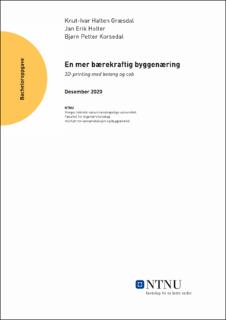| dc.contributor.advisor | Johansen, Fred | |
| dc.contributor.author | Græsdal, Knut-Ivar | |
| dc.contributor.author | Holter, Jan Erik | |
| dc.contributor.author | Korsedal, Bjørn Petter | |
| dc.date.accessioned | 2021-09-24T19:21:54Z | |
| dc.date.available | 2021-09-24T19:21:54Z | |
| dc.date.issued | 2020 | |
| dc.identifier | no.ntnu:inspera:66756336:9276044 | |
| dc.identifier.uri | https://hdl.handle.net/11250/2782269 | |
| dc.description.abstract | Vi har skrevet denne oppgaven med tanke på at den skal være en forstudie for videre fordypende arbeider innen temaet. Tittelen «En mer bærekraftig byggenæring - 3D-printing med betong og cob» gjenspeiler at temaet er 3D-printing av bygningskonstruksjoner, og antyder at teknologien 3DCP kan være med på å bidra til en mer bærekraftig utvikling innen byggenæringen.
Oppgavens problemstilling følger opp tittelen, og lyder som følgende: Hvordan kan additiv tilvirkning med 3D-printing av betong gjøre byggenæringen mer bærekraftig?
For å belyse og besvare problemstillingen har vi utført en tradisjonell litteraturstudie der vi gjennomgår dagens status innen bruk av betong og cob som materiale for 3D-printing, idet har vi også studert hvilke aktører og teknologi som er lengst fremme. Som en forlengelse av dette har vi sett nærmere på et spesielt bærekraftprosjekt hvor det er 3D-printet et hus med cob som materiale. Med innspill fra MAPEI, og en av de ledende aktørene innen 3D-printing, WASP, har vi for videre utarbeidelse av en LCA-analyse, satt opp en enkel sammenstilling for prosjektets CO2-avtrykk.
3DCP er en forholdsvis ung teknologi som fortsatt er preget av utprøving og forskning. Det fremstår sannsynlig at vi vil se sterk vekst og utvikling av denne teknologien i de kommende årene, også for printing med cob som materiale. For å finne ut om 3DCP kan bli en teknologi for bærekraftig bygging fant vi det nyttig å også se nærmere på betong som byggemateriale. Sement- og betongindustrien har høyt fokus på reduksjon av CO2-utslippene, og det foregår spennende forskning på nye betongsammensetninger. Betong er det byggematerialet som har vært mest brukt i fortid, nåtid, og vil antakelig være det i fremtiden også. | |
| dc.description.abstract | This thesis is written as a preliminary study for further in-depth research within the topic. The title "A more sustainable construction industry - 3D printing with concrete and cob" reflects that the theme is 3D printing of building structures and suggests that the 3DCP technology can contribute to a more sustainable development in the construction industry.
The thesis problem formulation is connected to the title, and reads as follows:
How can additive manufacturing with 3D printing of concrete make the construction industry more sustainable?
To clarify and address the thesis problem formulation, we have carried out a traditional literature study in which we review the current status of the use of concrete and cob as a material for 3D printing, with this we have also studied which companies and technology are at the forefront. As an additional contribution we have studied a sustainability project where a house is 3D printed with cob as building material. With input from MAPEI, and with one of the leading developers of 3D printing systems, WASP, we have for further preparation of an LCA analysis, set up a simple compilation for the project's CO2 footprint.
3DCP is a relatively young technology that is still characterized by testing and research. It seems likely that we will see strong growth and development of this technology in the coming years, also for printing with cob as material. To find out if 3DCP can become a technology for sustainable construction, we found it useful to take a closer look at concrete as a building material. The cement and concrete industry have a high focus on reducing CO2 emissions, and there is exciting research on new concrete compositions. Concrete is the building material that has been most used in the past, present, and will probably be in the future as well. | |
| dc.language | | |
| dc.publisher | NTNU | |
| dc.title | En mer bærekraftig byggenæring - 3D-printing med betong og cob | |
| dc.type | Bachelor thesis | |
